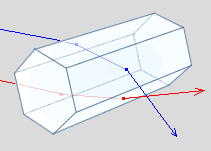
OPOD
What's New
Rays & Shadows
Water Droplets
Rainbows
Ice Halos
Contents
Crystals
Frequent Halos
22° circular
Sundogs
Tangent Arcs
Solar altitude
More Images
Circumscribed
Pillars
Circumzenithal
Circumhorizon
Parhelic Circle
Infrequent Halos
Multiple Displays
Other Worlds
Observing Halos
HaloSim
High Atmosphere
Links & Resources
Search - Index
123456789012345678
| Tangent Arcs |
| Intense upper tangent arc. The gull winged arc always touches the 22º halo at a point directly above the sun. Its wings open and then droop as the sun climbs. Here it was 22º high. Imaged by Malcolm Garland at Sheffield, England on 9th February '01. � Malcolm Garland, reproduced with permission. |
 |
||
| Singly oriented column crystal with upper and lower Tangent Arc rays. The rays enter a prism side face and leave through another inclined 60º to the first. |
The best tangent arcs wing
outwards from where they touch the 22º halo directly above and below
the sun. Their colours are bright yet delicate. Red is sunward. On less
favourable days they can be just local brightenings of the 22� halo.
The upper and lower arcs change shape considerably between sunrise and
noon. Look at their variations in the animation.
When the sun climbs above 29º both arcs join into a single halo wrapped
right around the sun - the "circumscribed
halo".
Tangent arcs form when cirrus clouds have well developed columnar
ice crystals drifting with their long axes almost horizontal.
These are called "singly oriented columns" because
having their long axes horizontal is their only orientation constraint.
They can take up any rotational position around their long axis and a
vertical axis. This crystal orientation is a common one
and produces a number of different halos.
The rays of tangent arcs enter a side face and leave directly through
another inclined 60º to the first. As in the rays forming the
22º halo, a deflection of 22º
after the two refractions is the angle of minimum deviation
but larger ray deviations occur as well. Thus the tangent arcs touch the
22º halo but rays deviated through larger angles (including skew
rays) form its 'wings'.
Red light is refracted less strongly than other colours and so the halo edge closest to the sun is red. The halo's colours are much more apparent
when seen directly, photographs rarely do them justice.
Tangent arc rays pass through the same crystal faces as those of the 22º
halo and sundogs. The essential
difference in the formation of the three halos is the orientation
of their crystals.